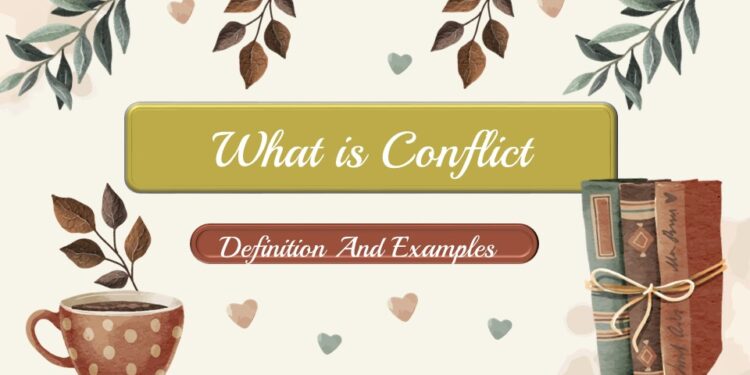What is Conflict Definition And Examples
Conflict is a fundamental element of literature that drives the narrative forward and creates tension and intrigue for readers. It refers to the struggle or clash between opposing forces, ideas, or characters within a story. Conflict serves as the catalyst for character development, plot progression, and the exploration of themes and ideas.
Whether it is internal or external, individual or societal, conflict plays a vital role in shaping the narrative structure and engaging readers.
Also Read-
- What is Climax Definition And Examples
- What is Characterization Definition And Example
- What is Colloquialism Definition And Examples
Types of Conflict:
- Man vs. Self (Internal Conflict): This type of conflict occurs within a character’s mind. It is a struggle between a character’s desires, emotions, beliefs, or moral dilemmas. Internal conflict often explores themes of self-discovery, inner turmoil, or the battle between right and wrong. What is Conflict Definition And Examples For example, in Fyodor Dostoevsky’s novel “Crime and Punishment,” the protagonist, Raskolnikov, experiences an internal conflict as he grapples with guilt and wrestles with his conscience after committing a crime.
- Man vs. Man (External Conflict): This type of conflict involves a direct clash between two or more characters. It can be a physical, verbal, or emotional confrontation between individuals with opposing goals, values, or beliefs. Man vs. man conflict often drives the plot and creates dramatic tension. What is Conflict Definition And Examples A classic example of this conflict is found in William Shakespeare’s play “Romeo and Juliet,” where the Montagues and Capulets engage in a bitter feud that leads to tragic consequences.
- Man vs. Nature (External Conflict): This type of conflict portrays the struggle between a character or characters and the forces of nature. What is Conflict Definition And Examples It can involve survival against the elements, natural disasters, or the inherent dangers of the environment. What is Conflict Definition And Examples In Ernest Hemingway’s novel “The Old Man and the Sea,” the protagonist, Santiago, engages in a fierce battle with a marlin and must overcome the relentless power of the sea.
- Man vs. Society (External Conflict): This type of conflict depicts the clash between a character or a group of characters and the norms, expectations, or injustices of society. It explores themes of social inequality, discrimination, rebellion, or the fight for justice. What is Conflict Definition And Examples George Orwell’s dystopian novel “1984” presents a powerful man vs. society conflict as the protagonist, Winston Smith, challenges the oppressive regime and attempts to maintain his individuality in a totalitarian society.
- Man vs. Supernatural (External Conflict): This type of conflict involves a confrontation between a character or characters and supernatural beings, forces, or events. It can include encounters with ghosts, monsters, mythical creatures, or supernatural occurrences. What is Conflict Definition And Examples In Bram Stoker’s novel “Dracula,” the conflict arises as the protagonist, Jonathan Harker, and other characters face the supernatural powers and threat posed by Count Dracula.
Importance of Conflict:
- Drives the Plot: Conflict provides the impetus for the story’s events and actions. It creates obstacles, challenges, and complications that characters must overcome, driving the plot forward and keeping readers engaged.
- Reveals Character: Conflict allows readers to witness how characters respond to challenges, revealing their strengths, weaknesses, values, and beliefs. What is Conflict Definition And Examples It offers opportunities for character development and growth throughout the narrative.
- Creates Tension and Suspense: Conflict generates suspense and tension, keeping readers invested in the story. The unresolved conflicts and obstacles faced by characters create anticipation, making readers eager to see how the conflicts will be resolved.
- Explores Themes and Ideas: Conflict often serves as a vehicle for exploring deeper themes and ideas within a literary work. It can highlight social issues, moral dilemmas, philosophical questions, or the complexities of human nature.
- Evokes Emotional Responses: Conflict elicits emotional responses from readers as they empathize with characters and become emotionally invested in their struggles. What is Conflict Definition And Examples It creates a sense of catharsis and allows readers to reflect on their own experiences and emotions.
- Offers Resolutions and Transformations: Conflict resolution provides closure and satisfaction to readers. It allows for character growth, transformation, and the resolution of conflicts, leading to a sense of catharsis and fulfillment.
Examples of Conflict
- “To Kill a Mockingbird” by Harper Lee: The novel explores the conflict between justice and prejudice in a racially divided society. The protagonist, Scout, observes her father, Atticus Finch, defending an innocent black man accused of rape, facing hostility and prejudice from the community.
- “Lord of the Flies” by William Golding: The story portrays the conflict between civilization and savagery as a group of boys stranded on an island descend into chaos and violence. The characters struggle to maintain order and confront their inner primal instincts.
- “The Great Gatsby” by F. Scott Fitzgerald: The novel presents a conflict between illusion and reality, as the protagonist, Jay Gatsby, pursues his unattainable love interest, Daisy Buchanan, and faces the consequences of his illusions and the corrupt nature of the American Dream.
- “Macbeth” by William Shakespeare: The play revolves around the conflict between ambition and morality as the titular character succumbs to his ambition for power, leading to his tragic downfall and inner turmoil.
- “The Hunger Games” by Suzanne Collins: The novel depicts a conflict between the oppressive Capitol and the oppressed districts, where teenagers are forced to participate in a televised fight to the death. The protagonist, Katniss Everdeen, becomes the symbol of rebellion and challenges the injustice of the system.
Conclusion
Conflict is a crucial component of literature that fuels the narrative, creates tension, and allows for the exploration of themes and character development. What is Conflict Definition And Examples Whether it is internal or external, individual or societal, conflict plays a significant role in shaping the plot, engaging readers, and eliciting emotional responses. What is Conflict Definition And Examples It drives the story forward, reveals the complexities of human nature, and provides opportunities for resolution and transformation. What is Conflict Definition And Examples Conflict adds depth, excitement, and meaning to literary works, making them compelling and thought-provoking.
FAQ.
Q. Is conflict necessary in every piece of literature?
Ans. Conflict is not a mandatory element in every piece of literature, but it is a prevalent and effective tool used by authors to engage readers and drive the narrative. While some literary works may focus more on introspection or contemplation, conflict is often employed to create tension and propel the story forward.
Q. Can conflict exist within a single character?
Ans. Yes, internal conflict, also known as man vs. self, occurs within a character’s mind and can be a significant driving force in a story. It explores the character’s desires, struggles, and moral dilemmas, contributing to their personal growth and development.
Q. Can a literary work have multiple conflicts?
Ans. Yes, it is common for literary works to have multiple conflicts. Different characters may experience their own conflicts, and these conflicts may intersect or intertwine throughout the narrative. Multiple conflicts can enhance the complexity and depth of the story, offering various layers of tension and resolution.
Q. Is conflict limited to traditional forms of literature?
Ans. No, conflict is not limited to traditional forms of literature such as novels and plays. It can be found in various literary forms, including short stories, poems, and even non-fiction works. Conflict is a fundamental element in storytelling, regardless of the medium or genre.
Q. Can conflict be symbolic or metaphorical?
Ans. Yes, conflict can be symbolic or metaphorical, representing deeper ideas or concepts beyond the immediate clash between characters or forces. Symbolic conflict adds layers of meaning to the narrative and allows for the exploration of abstract themes or philosophical concepts.
















